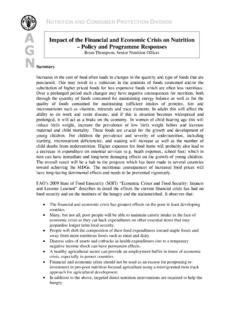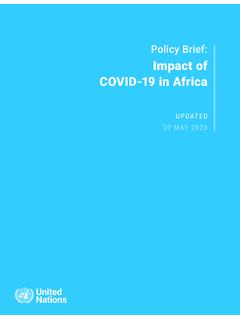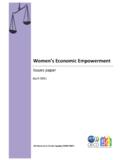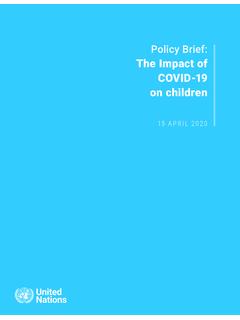Transcription of FAO Results in the Near East and North Africa Region- 2020-21
1 January 2022 NERC/22/2 Documents can be consulted at NH959/e E FAO REGIONAL CONFERENCE FOR NEAR EAST Thirty-sixth Session 10-13 January 2022 and 7-8 February 2022 FAO Results in the Near East and North Africa 2020-21 Executive Summary Over the 2020-21 biennium, FAO has taken significant steps toward reorienting its programme of work in NENA countries to better contribute to agrifood system transformation and the SDG targets related to food and agriculture. This includes the focus on four interconnected regional priorities, the introduction of new working modalities and innovative initiatives at the regional and country level.
2 This document highlights some of the most salient Results and achievements made over the 2020-21 period while distilling key lessons learned. Suggested action by the Regional Conference The Regional Conference is invited to call upon Members to: a) Take note of the progress made in re-orienting FAO s programme of work in the region to achieve more inclusive, sustainable, resilient and nutrition-sensitive agrifood systems. b) Provide feedback on the achievements and success of new working modalities and initiatives implemented and the lessons learned for the coming biennium. Queries on the content of this document may be addressed to: RNE NERC Secretariat 2 NERC/22/2 Introduction 1.
3 This document presents major developments and principal Results achieved in the region during the 2020-21 biennium. It also highlights FAO s new ways of working, modalities and initiatives introduced in 2020-21 to contribute to supporting the 2030 Agenda for Sustainable Development through the transformation to MORE efficient inclusive, resilient and sustainable agrifood systems for better production, better nutrition, a better environment, and a better life, leaving no one behind. 2. Since the arrival of Director-General QU Dongyu in August 2019, FAO has undergone deep transformative actions to ensure that FAO is fit-for-purpose to face the challenges that lie ahead.
4 FAO has introduced a modular and flexible structure that allows for optimal cross-sectoral collaboration and aims for a stronger and coordinated focus on the Sustainable Development Goals (SDGs). Among the changes introduced are: the new Office of Innovation to consolidate and strengthen FAO s innovative spirit; the new Office of SIDS, LDCs and LLDCs1 to ensure that the special needs of these vulnerable populations and countries are met; the new Office of SDGs which coordinates the corporate engagement in the 2030 Agenda follow-up and review; and FAO s new position of Chief Scientist which ensures robustness, breadth and independence of scientific approaches in FAO s work.
5 3. The reforms introduced also aim at modernizing FAO and improving its methods of work and transparency, including through the establishment of the Core Leadership team, comprised of the three Deputy Directors-General, the Chief Economist and Chief Scientist and the Director of Cabinet. 4. In 2020-21 , FAO rapidly transitioned to a fully digital Organization, further accelerated by the COVID-19 pandemic, with the expanded use of cloud solutions and the introduction of new technologies facilitating the work of the Organization from any location and paving the way for the new normal . Virtual meetings of the Governing Bodies, including the Regional Conferences in 2020, allowed governance processes to proceed smoothly, with interpretation provided in all FAO languages.
6 5. Furthermore, during the biennium, a number of key corporate initiatives were introduced, such as the Hand-in-Hand Initiative (HIHI), which is FAO s evidence-based, country-led and country-owned initiative to accelerate agricultural transformation and sustainable rural development in support of the SDGs, and the COVID-19 Response and Recovery Programme which appeals for immediate-, medium- and longer-term actions to prevent the health crisis from becoming a food crisis . 6. In 2020-21 , FAO fully aligned its country-level planning with the UN Sustainable Development Cooperation Framework (UNSDCF) process, thus building on the UN development system (UNDS) efforts to collectively support country ownership and address national SDG priorities and gaps.
7 At the same time, FAO s country level process also contributes to shaping the formulation of the UNSDCF, thus ensuring that agrifood system transformation concerns and related SDGs are well integrated and prioritized in the UN common planning documents. 7. Following the 35th Session of the Regional Conference for the Near East held in 2020, FAO focused its work in the region through the following Regional Priorities: Regional Priority 1: Rural transformation for youth employment and income; Regional Priority 2: Developing food systems that promote food security and healthy diets for all; Regional Priority 3: Greening agriculture: addressing water scarcity, ensuring environmental sustainability and implementing climate action; Regional Priority 4: Building resilience to protracted crises and emergency situations.
8 1 Small Island Developing States (SIDS); Least Developed Countries (LDCs); Land-Locked Developing Countries (LLDCs) NERC/22/2 3 8. These Regional Priorities served as a mechanism for delivery at country level, facilitating greater impact of FAO s work on the key priorities in each region under the Results framework for the biennium as presented in the Updated Results Framework 2020-21 . 9. The next section describes achievements of the region in 2020-21 , focusing on corporate and regional priorities in the context of FAO s work. The section also highlights relevant cross-cutting themes and thematic areas important for ensuring the quality and integrity of FAO s work.
9 I. Achievements in the region 10. The previous biennium has witnessed a number of important achievements at both regional and country level following the introduction and implementation of key initiatives by the FAO Director-General and re-formulation of regional priorities to better respond to Members needs. While not exhaustive, the following sections capture key Results realized through i) the introduction of new ways of working; ii) notable partnerships and cross-cutting approaches; and iii) revised regional priorities. A. FAO s new ways of working, modalities and programmes Hand-in-Hand Initiative 11.
10 FAO s Hand-in-Hand Initiative strives to facilitate agrifood systems transformation and sustainable rural development accelerated through targeting the poorest and the hungry, differentiating territories and strategies and bringing together all relevant dimensions through analysis and partnerships. Launched in July 2020, FAO's Hand-in-Hand Geospatial Platform is a digital public good to facilitate partnerships and provide advanced geo-spatial modelling and analytics, to identify real-time gaps and opportunities to raise the incomes and reduce the inequities and vulnerabilities of rural populations. The Sudan, Syria and Yemen are the NENA countries currently engaged in this initiative.














